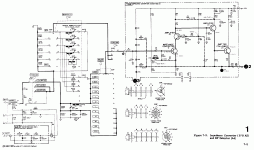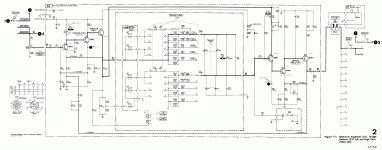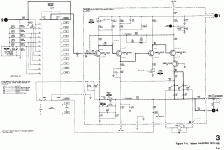Hello
Is anyones know any possibles improvements of those circuits or parts ; the impedance converter and the rejection amplifier/bridge balance circuits of my HP-333A distortion analyser ?
I include the HP-333A circuits images, the concerned circuits are in first two images.
Thank you
Bye
Gaetan
Is anyones know any possibles improvements of those circuits or parts ; the impedance converter and the rejection amplifier/bridge balance circuits of my HP-333A distortion analyser ?
I include the HP-333A circuits images, the concerned circuits are in first two images.
Thank you
Bye
Gaetan
Attachments
Last edited:
Hi Gaetan,
I don't have so much to contribute with more than that I had the same idea but with my over 20 years old scope, things I could think of is to get better transistors, especially in the scope case I think there are many more nice RF transistors these days, maybe some better capacitors and replace old dry electrolytic capacitors. Metal film resistors might be a good replacement in case of other types were used in crucial parts of the circuitry.
Did you have any list of what transistors are used or maybe you see it on the packages.
Cheers Michael
I don't have so much to contribute with more than that I had the same idea but with my over 20 years old scope, things I could think of is to get better transistors, especially in the scope case I think there are many more nice RF transistors these days, maybe some better capacitors and replace old dry electrolytic capacitors. Metal film resistors might be a good replacement in case of other types were used in crucial parts of the circuitry.
Did you have any list of what transistors are used or maybe you see it on the packages.
Cheers Michael
What makes you think it can be improved? My experience with the hp333A is that it's pretty much perfect as is. In what way could it be improved?
Test equipment isn't like audio, where parts choice makes it sound better - test equipment is designed for a job and it either does that job, or it doesn't. And if it doesn't, then it's faulty and can be repoaired.
And I'm talking from two points of view at once here:
1/ an ex HP service tech who has repaired 333A's
2/ an avid Upgrader and modifier of hi fi equipment.
Regards, Allen
Test equipment isn't like audio, where parts choice makes it sound better - test equipment is designed for a job and it either does that job, or it doesn't. And if it doesn't, then it's faulty and can be repoaired.
And I'm talking from two points of view at once here:
1/ an ex HP service tech who has repaired 333A's
2/ an avid Upgrader and modifier of hi fi equipment.
Regards, Allen
Hello
The HP-333A do have 80db of rejection of the fundamental frequency, is it possible to improve that ?
Thank you
Bye
Gaetan
The HP-333A do have 80db of rejection of the fundamental frequency, is it possible to improve that ?
Thank you
Bye
Gaetan
To get more than the standard 80dB notch, the notch's Q will have to be raised a LOT, which means the tuning will be FAR more critical, and drift will become an almost impossible problem.
It is what it is, and I believe any attempts to "improve it" will just screw it up.
It was designed for normal audio usage, not a research project into ultra low distortion levels.
But it can be VERY useful as a front end for a 24 bit computer based spectrum analyser system, the 333A's notch will allow the computer to have a far deeper look into the harmonics. And allow convenient gain changing/attenuation, things often very hard to arrange with a regular sound card and software.
Regards, Allen
It is what it is, and I believe any attempts to "improve it" will just screw it up.
It was designed for normal audio usage, not a research project into ultra low distortion levels.
But it can be VERY useful as a front end for a 24 bit computer based spectrum analyser system, the 333A's notch will allow the computer to have a far deeper look into the harmonics. And allow convenient gain changing/attenuation, things often very hard to arrange with a regular sound card and software.
Regards, Allen
- Status
- Not open for further replies.


